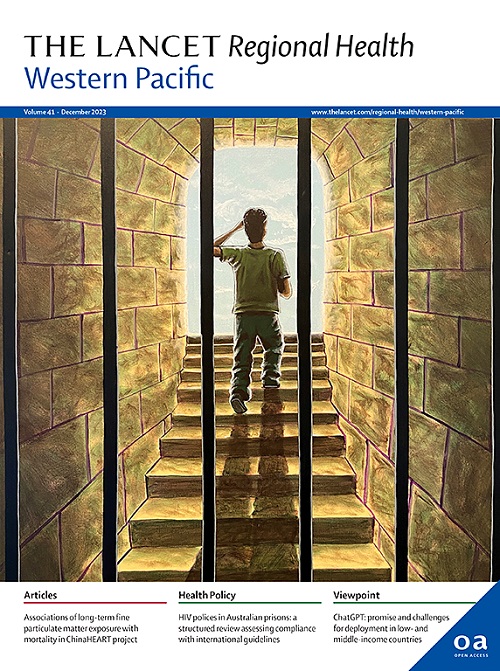Long-term exposure to outdoor fine particulate and physical activity with mortality and cardiovascular events: an analysis of the Prospective Urban Rural Epidemiology (PURE)-China cohort study
IF 7.6
1区 医学
Q1 HEALTH CARE SCIENCES & SERVICES
引用次数: 0
Abstract
Background
Long-term exposure to PM2.5 and low physical activity are independently associated with an increased risk of cardiovascular disease (CVD). However, there is limited research investigating the combined effects of PM2.5 exposure and physical activity on CVD risk. This study aims to explore these interactions related to CVD and mortality.
Methods
We analysed data from the PURE-China cohort, including 39,970 adults aged 35–70 years, with a median follow-up of 11.9 years. PM2.5 exposure was estimated using a Bayesian hierarchical model. Physical activity was quantified using metabolic equivalent task (MET)-minutes per week. The primary outcome was a composite of all-cause mortality and major cardiovascular events. Cox frailty models and restricted cubic splines were used to assess associations. Interaction effects were evaluated using measures of multiplicative and additive interaction, including the relative excess risk due to interaction (RERI) and the proportion attributable to interaction (AP).
Findings
Participants were divided into high and low PM2.5 exposure groups by the median concentration (47.70 μg/m3). In low-exposure areas, higher total physical activity significantly reduced the risk of composite outcome (HR: 0.84, 95% CI: 0.73–0.97, p trend = 0.012) and major cardiovascular events (HR: 0.80, 0.67–0.95, p trend = 0.022). However, in high-exposure regions, physical activity showed no protective effect for the composite outcome (HR: 0.97, 0.85–1.09, p trend = 0.551) and major cardiovascular events (HR: 0.98, 0.85–1.13, p trend = 0.864). Higher non-recreational physical activity reduced the risks of composite outcome and major CVD in low-exposure areas but provided no benefit in high-exposure regions (p interaction = 0.011, 0.024, respectively). Significant antagonistic interaction was observed between high PM2.5 exposure and low non-recreational physical activity for the composite outcome (RERI: −0.215, 95% CI: −0.406 to −0.024; AP: −0.155, 95% CI: −0.294 to −0.017).
Interpretation
Long-term exposure to high PM2.5 concentrations diminishes the cardiovascular benefits of physical activity, particularly non-recreational activities. These findings underscore the need for tailored physical activity guidelines and air quality interventions in heavily polluted regions to maximize public health benefits.
Funding
Funding sources are listed at the end of the Article.
长期暴露于室外细颗粒物和体力活动与死亡率和心血管事件的关系:一项前瞻性城乡流行病学(PURE)中国队列研究分析
长期暴露于PM2.5和低体力活动与心血管疾病(CVD)风险增加独立相关。然而,关于PM2.5暴露和身体活动对心血管疾病风险的综合影响的研究有限。本研究旨在探讨这些相互作用与心血管疾病和死亡率的关系。方法:我们分析PURE-China队列的数据,包括39,970名年龄在35-70岁之间的成年人,中位随访时间为11.9年。使用贝叶斯分层模型估计PM2.5暴露量。用代谢当量任务(MET)每周分钟来量化身体活动。主要终点是全因死亡率和主要心血管事件的综合结果。使用Cox脆弱模型和受限三次样条来评估相关性。使用乘法和加性相互作用来评估相互作用效应,包括由于相互作用的相对超额风险(rei)和归因于相互作用的比例(AP)。根据PM2.5中位数浓度(47.70 μg/m3)将参与者分为高暴露组和低暴露组。在低暴露地区,较高的总体力活动显著降低了复合结局(HR: 0.84, 95% CI: 0.73-0.97, p趋势= 0.012)和主要心血管事件(HR: 0.80, 0.67-0.95, p趋势= 0.022)的风险。然而,在高暴露地区,体力活动对复合结局(HR: 0.97, 0.85-1.09, p趋势= 0.551)和主要心血管事件(HR: 0.98, 0.85-1.13, p趋势= 0.864)没有保护作用。在低暴露地区,较高的非娱乐性体育活动降低了复合结局和主要心血管疾病的风险,但在高暴露地区没有任何益处(p相互作用分别= 0.011,0.024)。高PM2.5暴露与低非娱乐性身体活动之间存在显著的拮抗相互作用(rei: - 0.215, 95% CI: - 0.406至- 0.024;AP:−0.155,95% CI:−0.294 ~−0.017)。长期暴露在高浓度PM2.5环境中会降低身体活动(尤其是非娱乐性活动)对心血管的益处。这些发现强调需要在严重污染地区制定量身定制的体育活动指南和空气质量干预措施,以最大限度地提高公共卫生效益。资金来源在文章末尾列出。
本文章由计算机程序翻译,如有差异,请以英文原文为准。
求助全文
约1分钟内获得全文
求助全文
来源期刊

The Lancet Regional Health: Western Pacific
Medicine-Pediatrics, Perinatology and Child Health
CiteScore
8.80
自引率
2.80%
发文量
305
审稿时长
11 weeks
期刊介绍:
The Lancet Regional Health – Western Pacific, a gold open access journal, is an integral part of The Lancet's global initiative advocating for healthcare quality and access worldwide. It aims to advance clinical practice and health policy in the Western Pacific region, contributing to enhanced health outcomes. The journal publishes high-quality original research shedding light on clinical practice and health policy in the region. It also includes reviews, commentaries, and opinion pieces covering diverse regional health topics, such as infectious diseases, non-communicable diseases, child and adolescent health, maternal and reproductive health, aging health, mental health, the health workforce and systems, and health policy.
 求助内容:
求助内容: 应助结果提醒方式:
应助结果提醒方式:


